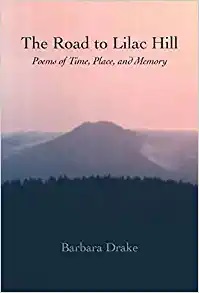A Review of Barbara Drake’s The Road to Lilac Hill
The Road to Lilac Hill, Barbara Drake. Windfall Press, 2018. 112 pages. $18.00
by Craig Cotter
Many of us have loved Barbara Drake’s poetry for 40 years, since her first full-length collection, Love at the Egyptian Theatre, was published in 1978.
Most Americans do not know Barbara Drake’s work.
If this brief review of her latest book, The Road to Lilac Hill, succeeds in having you purchase and read it, you will immediately begin searching bookstores for all of Drake’s poetry.
Barbara Drake, who just turned 80, is an American master.
She has lived for many decades on a farm in rural Oregon—fields, woods, a vineyard, chickens, sheep and ever-present border collies. Mother, grandmother, wife and daughter, Drake’s poems have often been praised as reflections on “everyday life.” She walks the fields, woodlands and streams of the Pacific Northwest. But her poems are never about simply bucolic country life, any more than Whitman’s wanderings, shared in verse, were simply a rehash of the rhyming, metric poetry common in 19th Century America.
Barbara Drake writes directly form the Whitman Tradition. On this 200th anniversary of Whitman’s birth, The Road to Lilac Hill reverently binds the Whitman Tradition in American poetry with the 21st Century.
The title of Drake’s new book references the street she lives on, Lilac Hill Road:
I sing of my road whose name bears numbers for counting and adding up
so that messages can arrive in a timely fashion,
whose name resonates of compass, winds, and the intricate labors of cartographers.
My road lends me its identity so that others can find me
and so I can venture out and find my way back
by this road which is mine and yet also shared with others.
When Barbara Drake’s poetry touches a subject—a walk through fields of flowers, reflections on death, playing tag with her grandchildren in a field of tall grass, your life is forever changed. Your address becomes a touchstone for American poetry clear as Whitman’s Mickle Street. And only a dilettante would consider such art “every day” or “commonplace.”
Drake:
Bill mows paths in the sheep pasture,
a maze to follow.
Each golden stem, each
narrow leaf and seed head
a conduit for light.
Grass seeds cover
the littlest grandson’s head
like sesame seeds on a round bun.
Pasture wildflowers—
brodiaea, dandelions, daisies,
purple vetch, blue flax…
Whitman:
The commonplace I sing…
The open air I sing, freedom, toleration…
The common day and night—the common earth and waters,
Your farm…
The democratic wisdom underneath, like solid ground for all.
—1891/1892
In her poem “Wild Farm,” we walk with Drake as she observes and describes a vast variety of native Oregon flowers and plants—33 species from my quick count—
“Oemleria, also known as Indian plum…yellow dogtooth, pink trout lilies…chocolate lily…yellow violets, shooting stars, the deep pink Nootka rose…flax, orange columbine,
…pink checker mallows…fool’s onion…”
And whereas Whitman is often charged with being humorless in his poetry, Drake often displays a subtle sense of humor in her poems that prevent any nature walks from turning into a drag.
After a list of wildflowers that would make Whitman proud, containing multitudes, our Oregonian poet, our American poet, will not pretend to know all:
There are the late
obscure pink flowers, waxy and small,
which I don’t know the name of.
We trust Drake to share with us crisp observations and understandings of the natural world—and we are regularly refreshed when experience is subsumed by nature:
What does it all mean?
It is just an old story
the farm tells over and over.
Drake masterfully engages readers with deep respect for a lesson taught by Whitman over 150 years ago:
Poets to Come
I am a man who, sauntering along without fully stopping, turns a
casual look upon you and then averts his face,
Leaving it to you to prove and define it,
Expecting the main things from you.
—1860/1867
It is up to us to find the “obscure pink flowers..,” we are challenged to explore old stories America tells us over and over. Drake is keenly and directly aware of the permission Whitman gives us in the first section of “Song of Myself”:
1
I permit to speak at every hazard,
Nature without check with original energy.
*
As Drake reflects on death, it is no mistake she finds herself with Whitman in a blackberry thicket. As in section 30 of “Song of Myself,” Whitman considers an afterlife with this unique image of American beauty:
“…the running blackberry would adorn the parlors of heaven…”
In her magnificent poem “About Time,” Drake’s contemplations of “the final moment of my life” link directly back a century-and-a-half to Whitman’s “running blackberry—”
I expect a tremendous wind to sweep across the landscape and leave
nothing standing but the blackberry thicket at the bottom of my
property.
*
“No sentimentalist, no stander above men and women or apart from them…” [Section 24, “Song of Myself”], Barbara Drake’s Road to Lilac Hill contains some of the most direct, accessible and beautiful poetry ever produced in America.
Somehow Drake—at age 80—is not a household name. In 1856, in “By Blue Ontario’s Shore,” Whitman provides us with a test we must not fail:
(The proof of a poet shall be sternly deferr’d till his country absorbs
him as affectionately as he has absorb’d it.)
For those who marveled at Drake’s Love at the Egyptian Theatre in 1978, and have followed her poetry ever since, our proof is not deferred.
Craig Cotter was born in 1960 in New York and has lived in California since 1986. His poems have appeared in Caliban Online, California Quarterly, Chiron Review, Columbia Poetry Review, Court Green, Free State Review, Great Lakes Review, Hawai’i Review, Ottawa Arts Review, Poetry New Zealand & Tampa Review. His fourth book of poems, After Lunch with Frank O’Hara, is currently available from Chelsea Station Editions. In 2011 his manuscript After Lunch was a finalist for the National Poetry Series. In 2019 his new manuscript, Alex, was a finalist for the Tampa Review Prize. www.craigcotter.com

